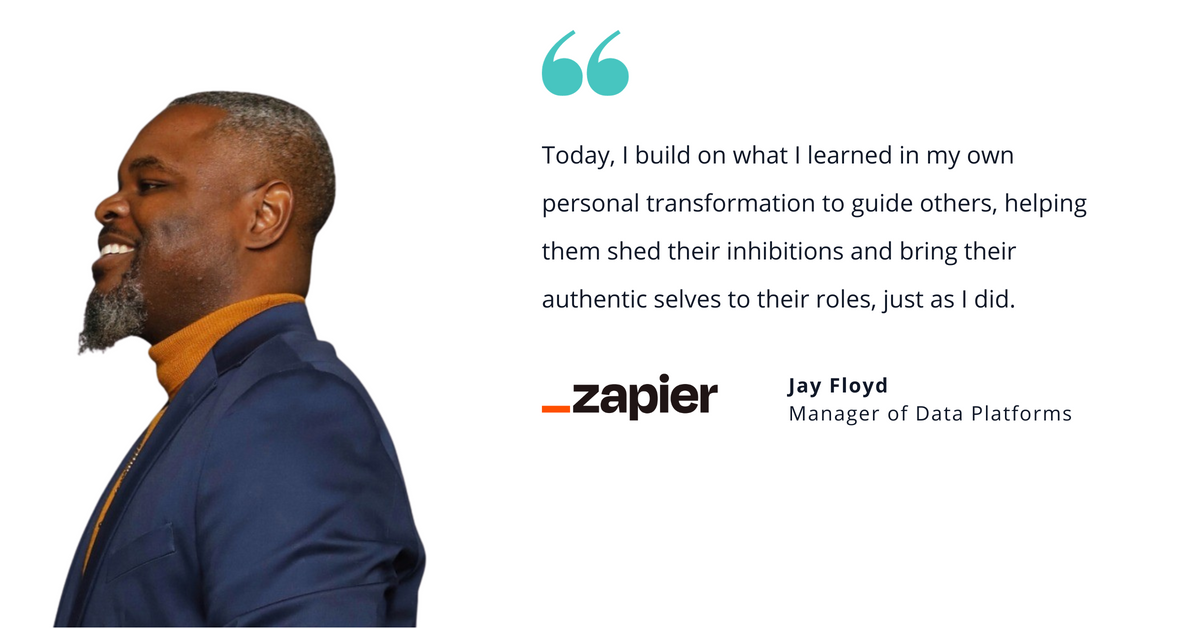Jay Floyd says he was an unusually introspective child.
“The loss of my big brother to gun violence during our teenage years was a turning point in my life, it propelled me on a journey of self-actualization much earlier than most,” Jay shares.
As he got older and joined the workforce, he noticed that he carried a lot of shame about his upbringing. But, he explains, it was learning to embrace his background that set the stage for his future calling: life coaching.
“By coaching myself to embrace my past and find the courage to bring my authentic self to work, I unlocked a new level of connection and understanding with my technology colleagues,” Jay explains. “Today, I build on what I learned in my own personal transformation to guide others, helping them shed their inhibitions and bring their authentic selves to their roles, just as I did.”
Now a Manager of Data Platforms at Zapier, Jay sat down with us to share how he builds coaching into his management approach — and how you can, too.
Venturing into life coaching
After studying information technology and taking his initial steps in engineering, Jay fell in love with tech; however, he noticed that the human experience often took a backseat in the industry.
“One quiet evening, as I sat at my desk at home, a realization washed over me: ‘You are a life coach,’” Jay shares with a smile. “It wasn't a new role or a sudden transformation; it was an acknowledgment of who I had always been. Throughout the challenges of my youth, I had been a pillar of support for my mother, guiding her through our toughest times. My friends had often turned to me during their moments of doubt, seeking advice and reassurance.”
When Jay recognized this natural gift, he decided to formalize the work he’d been doing for years and become a professional life coach alongside his technology role.
Lessons learned as a coach
Jay describes how “by merging [his] technical background with life coaching principals, [he’s] carved out a unique space where [he] can bridge the worlds of technology and human emotion, helping others in the tech industry find their own balance, purpose, and authenticity.”
Through coaching, he learned the power of active listening and pinpointing the emotions, fears, and aspirations behind someone’s words. He also discovered the universality of human experiences, despite our diverse backgrounds, and the transformative power of belief.
“Many folks came to me burdened by self-doubt and limiting beliefs. By simply holding space for them and believing in their potential, I’ve witnessed incredible transformations.”
When the opportunity presented itself for Jay to continue growing his technology career at Zapier, he was drawn to their internal coaching program.
“[This] was not only a great value-add, but also seeing that Zapier embraced coaching at every level was a good indicator to me as a candidate three years ago that this was the right place for me to continue my growth,” he says.
Bringing his inner-coach to management
Through Zapier’s internal coaching program, Jay learned to strike a balance between being both a technology manager and people coach.
“As I became a manager at Zapier, my natural inclination was towards coaching, but I was reminded that a manager's role is multifaceted, with coaching being just one of the many responsibilities.”
He now describes his management approach as “coaching-first,” meaning he prioritizes understanding, empowerment, and personal growth in each interaction.
“For me, a coaching-first approach begins with active listening. It's about really hearing each person–their aspirations, concerns, and feedback, and then using that understanding to guide and support them,” explains Jay. “Instead of providing immediate solutions or directives, I usually start by asking open-ended questions, encouraging team members to explore their thoughts and arrive at their own insights. This not only fosters a sense of ownership but also helps in developing critical thinking skills.”
Jay also explains how implementing a coaching-first approach involves recognizing the uniqueness of each person’s journey.
“It's about providing tailored support, celebrating successes, and viewing challenges as opportunities for growth,” he says. “For instance, when a team member recently achieved a significant milestone, instead of just celebrating the achievement, we also reflected on the journey, discussing the learnings, challenges, and growth that came with it.”
The impact
Since implementing a coaching-first leadership approach at Zapier, Jay has witnessed transformative changes.
These include:
- Enhanced team collaboration: By fostering an environment of open communication and active listening, team members feel more comfortable sharing their ideas, concerns, and feedback. This has led to richer brainstorming sessions, more innovative solutions, and a collective sense of ownership over projects.
- Empowered decision-making: Instead of relying solely on top-down directives, team members are encouraged to explore their thoughts and arrive at their own insights. This empowerment has not only boosted their confidence but has also led to more informed and effective decision-making.
- Personalized growth plans: Through one-on-one coaching sessions, we've been able to tailor growth and development plans to each individual's strengths and aspirations. We talk about their identified strengths–not just what they’re good at, but what type of work energizes them–and find ways for them to operate in those strengths in their role.This personalized approach ensures that team members are not only meeting their professional goals but are also finding fulfillment in their roles.
- Increased resilience: Facing challenges and setbacks is an inevitable part of any job. However, with a coaching-first approach, team members are equipped with the tools to view these challenges as growth opportunities. This shift in perspective has increased resilience and adaptability across the team.
- Strengthened trust and rapport: Building relationships based on trust and understanding has been a cornerstone of this approach. As a result, there's a deeper sense of camaraderie and mutual respect among team members, leading to a more cohesive and harmonious work environment.
- Enhanced job satisfaction: Our commitment to working as a team that cares about the well-being of our stakeholders and ourselves has yielded remarkable results. We take immense pride in supporting each other, not only in delivering outstanding work but also in prioritizing mental health and work-life balance. This shared focus on the humanity of our team members and stakeholders has led to significant improvements in our employee satisfaction survey results.
- Holistic problem solving: Encouraging team members to approach challenges from a holistic standpoint, considering both technical and emotional aspects, has led to more comprehensive and sustainable solutions.
5 ways to implement a coaching-first approach
“Every piece of code, every data model, and every project has a human story behind it. As a leader, recognizing and valuing these stories has been instrumental in building a cohesive, motivated, and high-performing team. I’m proud to be a part of a team that celebrates our ability to ensure a team member’s undistracted parental leave just as loudly as we celebrate shipping code,” Jay says.
To help you implement a coaching-first leadership approach, Jay leaves you with five recommendations:
- Active listening: “At the heart of coaching is the ability to truly listen. Active listening involves fully concentrating, understanding, and responding to what the other person is saying without immediately jumping to solutions or judgments. This not only fosters trust but also ensures that the guidance provided is tailored to the individual's unique context.”
- Open-ended questioning: “Instead of providing direct answers or solutions, leaders can pose open-ended questions that encourage team members to think critically and arrive at their own insights. Questions like ‘How do you feel about this approach?’ or ‘What do you think could be a potential solution?’ empower individuals to take ownership of challenges and solutions.”
- Creating a safe space for feedback: “A coaching-first approach thrives in an environment where feedback is welcomed and valued. Leaders should cultivate a culture where team members feel safe to share their thoughts, concerns, and feedback without fear of retribution.”
- Personalized development plans: “Understanding that every team member brings their own unique strengths, aspirations, and challenges to the table is vital. As leaders, we can collaborate with each individual to craft customized development plans that align with their career objectives and personal growth ambitions. This allows us to act as a team, and get creative with ways we can look to leverage their strengths and ambitions to bring value to the org.”
- Being coachable: “One essential aspect of effective leadership is being open to coaching ourselves. Even the best coaches have their own coaches. It's vital that we demonstrate the same commitment to growth that we expect from our team members. This means being transparent when we display behaviors that don't align with our desired work environment and being receptive to feedback from our own managers or coaches. By modeling this continuous improvement, we can inspire trust and growth in those we lead.”
“I believe management and leadership in general are becoming more and more conducive to coaching principals,” says Jay. “I truly appreciate the environment of Zapier for being fertile ground for me to grow in my journey in this area.”
Interested in growing your career alongside leaders like Jay? You're welcome to apply to any open joins and join Zapier's talent community by filling out a general interest form on their jobs page. By doing so, you'll become a member of Zapier's talent community, which means you’ll be among the first candidates they review for each opening. You’ll also be invited to talent community workshops and receive quarterly newsletters to hear what’s new at Zapier.



